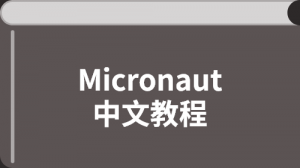上一节中的示例演示了 Micronaut 如何让您从 URI 路径变量绑定方法参数。本节介绍如何绑定请求其他部分的参数。
绑定注解
所有绑定注解都支持自定义被绑定的变量的名称及其名称成员。
下表总结了注释及其用途,并提供了示例:
表 1. 参数绑定注解
| 注解 |
描述 |
示例 |
|
@Body
|
从请求正文绑定
|
@Body String body
|
|
@CookieValue
|
从 cookie 绑定参数
|
@CookieValue String myCookie
|
|
@Header
|
绑定来自 HTTP 标头的参数
|
@Header String requestId
|
|
@QueryValue
|
从请求查询参数绑定
|
@QueryValue String myParam
|
|
@Part
|
从多部分请求的一部分绑定
|
@Part CompletedFileUpload file
|
|
@RequestAttribute
|
从请求的属性绑定。属性通常在过滤器中创建
|
@RequestAttribute String myAttribute
|
|
@PathVariable
|
从请求的路径绑定
|
@PathVariable String id
|
|
@RequestBean
|
将任何 Bindable 值绑定到单个 Bean 对象
|
@RequestBean MyBean bean
|
当绑定注释中未指定值时,将使用方法参数名称。换句话说,以下两个方法是等效的,并且都从名为 myCookie 的 cookie 绑定:
| Java |
Groovy |
Kotlin |
@Get("/cookieName")
public String cookieName(@CookieValue("myCookie") String myCookie) {
// ...
}
@Get("/cookieInferred")
public String cookieInferred(@CookieValue String myCookie) {
// ...
}
|
@Get("/cookieName")
String cookieName(@CookieValue("myCookie") String myCookie) {
// ...
}
@Get("/cookieInferred")
String cookieInferred(@CookieValue String myCookie) {
// ...
}
|
@Get("/cookieName")
fun cookieName(@CookieValue("myCookie") myCookie: String): String {
// ...
}
@Get("/cookieInferred")
fun cookieInferred(@CookieValue myCookie: String): String {
// ...
}
|
由于变量名称中不允许使用连字符,因此可能需要在注释中设置名称。下面的定义是等价的:
| Java |
Groovy |
Kotlin |
@Get("/headerName")
public String headerName(@Header("Content-Type") String contentType) {
// ...
}
@Get("/headerInferred")
public String headerInferred(@Header String contentType) {
// ...
}
|
@Get("/headerName")
String headerName(@Header("Content-Type") String contentType) {
// ...
}
@Get("/headerInferred")
String headerInferred(@Header String contentType) {
// ...
}
|
@Get("/headerName")
fun headerName(@Header("Content-Type") contentType: String): String {
// ...
}
@Get("/headerInferred")
fun headerInferred(@Header contentType: String): String {
// ...
}
|
流支持
Micronaut 还支持将正文绑定到 InputStream。如果该方法正在读取流,则必须将方法执行卸载到另一个线程池以避免阻塞事件循环。
使用 InputStream 执行阻塞 I/O
| Java |
Groovy |
Kotlin |
@Post(value = "/read", processes = MediaType.TEXT_PLAIN)
@ExecuteOn(TaskExecutors.IO) // (1)
String read(@Body InputStream inputStream) throws IOException { // (2)
return IOUtils.readText(new BufferedReader(new InputStreamReader(inputStream))); // (3)
}
|
@Post(value = "/read", processes = MediaType.TEXT_PLAIN)
@ExecuteOn(TaskExecutors.IO) // (1)
String read(@Body InputStream inputStream) throws IOException { // (2)
IOUtils.readText(new BufferedReader(new InputStreamReader(inputStream))) // (3)
}
|
@Post(value = "/read", processes = [MediaType.TEXT_PLAIN])
@ExecuteOn(TaskExecutors.IO) // (1)
fun read(@Body inputStream: InputStream): String { // (2)
return IOUtils.readText(BufferedReader(InputStreamReader(inputStream))) // (3)
}
|
控制器方法在IO线程池上执行
正文作为输入流传递给方法
流被读取
从多个查询值绑定
与其从请求的单个部分进行绑定,不如将所有查询值绑定到例如 POJO。这可以通过在 URI 模板中使用展开运算符 (?pojo*) 来实现。例如:
绑定请求参数到POJO
| Java |
Groovy |
Kotlin |
import io.micronaut.http.HttpStatus;
import io.micronaut.http.annotation.Controller;
import io.micronaut.http.annotation.Get;
import io.micronaut.core.annotation.Nullable;
import javax.validation.Valid;
@Controller("/api")
public class BookmarkController {
@Get("/bookmarks/list{?paginationCommand*}")
public HttpStatus list(@Valid @Nullable PaginationCommand paginationCommand) {
return HttpStatus.OK;
}
}
|
import io.micronaut.http.HttpStatus
import io.micronaut.http.annotation.Controller
import io.micronaut.http.annotation.Get
import javax.annotation.Nullable
import javax.validation.Valid
@Controller("/api")
class BookmarkController {
@Get("/bookmarks/list{?paginationCommand*}")
HttpStatus list(@Valid @Nullable PaginationCommand paginationCommand) {
HttpStatus.OK
}
}
|
import io.micronaut.http.HttpStatus
import io.micronaut.http.annotation.Controller
import io.micronaut.http.annotation.Get
import javax.validation.Valid
@Controller("/api")
open class BookmarkController {
@Get("/bookmarks/list{?paginationCommand*}")
open fun list(@Valid paginationCommand: PaginationCommand): HttpStatus {
return HttpStatus.OK
}
}
|
从多个可绑定值绑定
除了只绑定查询值,还可以将任何 Bindable 值绑定到 POJO(例如,将 HttpRequest、@PathVariable、@QueryValue 和 @Header 绑定到单个 POJO)。这可以通过 @RequestBean 注释和自定义 Bean 类来实现,该类具有带有 Bindable 注释的字段,或者可以按类型(例如 HttpRequest、BasicAuth、Authentication 等)绑定的字段。
例如:
将 Bindable 值绑定到 POJO
| Java |
Groovy |
Kotlin |
@Controller("/api")
public class MovieTicketController {
// You can also omit query parameters like:
// @Get("/movie/ticket/{movieId}
@Get("/movie/ticket/{movieId}{?minPrice,maxPrice}")
public HttpStatus list(@Valid @RequestBean MovieTicketBean bean) {
return HttpStatus.OK;
}
}
|
@Controller("/api")
class MovieTicketController {
// You can also omit query parameters like:
// @Get("/movie/ticket/{movieId}
@Get("/movie/ticket/{movieId}{?minPrice,maxPrice}")
HttpStatus list(@Valid @RequestBean MovieTicketBean bean) {
HttpStatus.OK
}
}
|
@Controller("/api")
open class MovieTicketController {
// You can also omit query parameters like:
// @Get("/movie/ticket/{movieId}
@Get("/movie/ticket/{movieId}{?minPrice,maxPrice}")
open fun list(@Valid @RequestBean bean: MovieTicketBean): HttpStatus {
return HttpStatus.OK
}
}
|
它使用这个 bean 类:
Bean定义
| Java |
Groovy |
Kotlin |
@Introspected
public class MovieTicketBean {
private HttpRequest<?> httpRequest;
@PathVariable
private String movieId;
@Nullable
@QueryValue
@PositiveOrZero
private Double minPrice;
@Nullable
@QueryValue
@PositiveOrZero
private Double maxPrice;
public MovieTicketBean(HttpRequest<?> httpRequest,
String movieId,
Double minPrice,
Double maxPrice) {
this.httpRequest = httpRequest;
this.movieId = movieId;
this.minPrice = minPrice;
this.maxPrice = maxPrice;
}
public HttpRequest<?> getHttpRequest() {
return httpRequest;
}
public String getMovieId() {
return movieId;
}
@Nullable
public Double getMaxPrice() {
return maxPrice;
}
@Nullable
public Double getMinPrice() {
return minPrice;
}
}
|
@Introspected
class MovieTicketBean {
private HttpRequest<?> httpRequest
@PathVariable
String movieId
@Nullable
@QueryValue
@PositiveOrZero
Double minPrice
@Nullable
@QueryValue
@PositiveOrZero
Double maxPrice
}
|
@Introspected
data class MovieTicketBean(
val httpRequest: HttpRequest<Any>,
@field:PathVariable val movieId: String,
@field:QueryValue @field:PositiveOrZero @field:Nullable val minPrice: Double,
@field:QueryValue @field:PositiveOrZero @field:Nullable val maxPrice: Double
)
|
bean 类必须使用@Introspected 进行自省。它可以是以下之一:
具有 setter 和 getter 的可变 Bean 类
具有 getter 和全参数构造函数(或构造函数或静态方法上的 @Creator 注释)的不可变 Bean 类。构造函数的参数必须匹配字段名称,这样对象就可以在没有反射的情况下被实例化。
由于 Java 不在字节码中保留参数名称,因此您必须使用 -parameters 编译代码才能使用来自另一个 jar 的不可变 bean 类。另一种选择是在您的源代码中扩展 Bean 类。
可绑定类型
通常,可以绑定任何可以通过 ConversionService API 从 String 表示形式转换为 Java 类型的类型。
这包括最常见的 Java 类型,但是可以通过创建类型为 TypeConverter 的 @Singleton bean 来注册其他 TypeConverter 实例。
可空性的处理值得特别提及。例如考虑以下示例:
| Java |
Groovy |
Kotlin |
@Get("/headerInferred")
public String headerInferred(@Header String contentType) {
// ...
}
|
@Get("/headerInferred")
String headerInferred(@Header String contentType) {
// ...
}
|
@Get("/headerInferred")
fun headerInferred(@Header contentType: String): String {
// ...
}
|
在这种情况下,如果请求中不存在 HTTP 标头 Content-Type,则路由被视为无效,因为它无法满足,并返回 HTTP 400 BAD REQUEST。
要使 Content-Type 标头可选,您可以改为编写:
| Java |
Groovy |
Kotlin |
@Get("/headerNullable")
public String headerNullable(@Nullable @Header String contentType) {
// ...
}
|
@Get("/headerNullable")
String headerNullable(@Nullable @Header String contentType) {
// ...
}
|
@Get("/headerNullable")
fun headerNullable(@Header contentType: String?): String? {
// ...
}
|
如果请求中没有标头,则传递一个空字符串。
也可以使用 java.util.Optional,但不鼓励将其用于方法参数。
此外,任何符合 RFC-1123 的 DateTime 都可以绑定到参数。或者,可以使用 Format 注释自定义格式:
| Java |
Groovy |
Kotlin |
@Get("/date")
public String date(@Header ZonedDateTime date) {
// ...
}
@Get("/dateFormat")
public String dateFormat(@Format("dd/MM/yyyy hh:mm:ss a z") @Header ZonedDateTime date) {
// ...
}
|
@Get("/date")
String date(@Header ZonedDateTime date) {
// ...
}
@Get("/dateFormat")
String dateFormat(@Format("dd/MM/yyyy hh:mm:ss a z") @Header ZonedDateTime date) {
// ...
}
|
@Get("/date")
fun date(@Header date: ZonedDateTime): String {
// ...
}
@Get("/dateFormat")
fun dateFormat(@Format("dd/MM/yyyy hh:mm:ss a z") @Header date: ZonedDateTime): String {
// ...
}
|
基于类型的绑定参数
一些参数通过它们的类型而不是它们的注释来识别。下表总结了参数类型及其用途,并提供了一个示例:
| 类型 |
描述 |
示例 |
|
BasicAuth
|
允许绑定基本授权凭据
|
BasicAuth basicAuth
|
可变分辨率
Micronaut 尝试按以下顺序填充方法参数:
URI 变量,如 /{id}。
如果请求是 GET 请求(例如?foo=bar),则来自查询参数。
如果有 @Body 并且请求允许主体,则将主体绑定到它。
如果请求可以有主体并且没有定义 @Body 则尝试解析主体(JSON 或表单数据)并从主体绑定方法参数。
最后,如果无法填充方法参数,则返回 400 BAD REQUEST。

